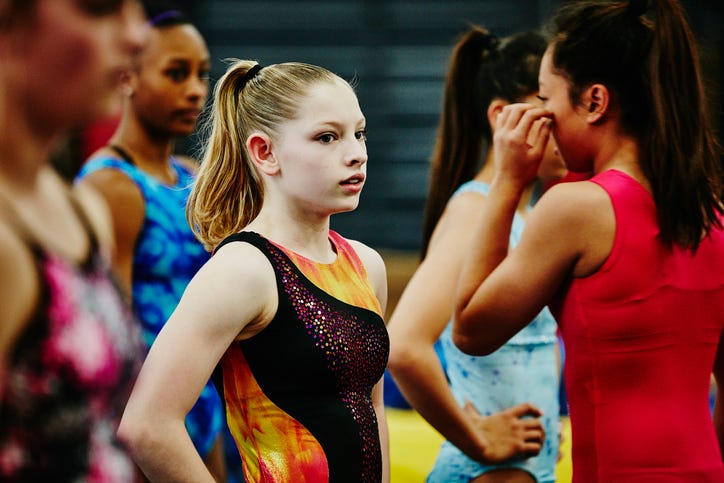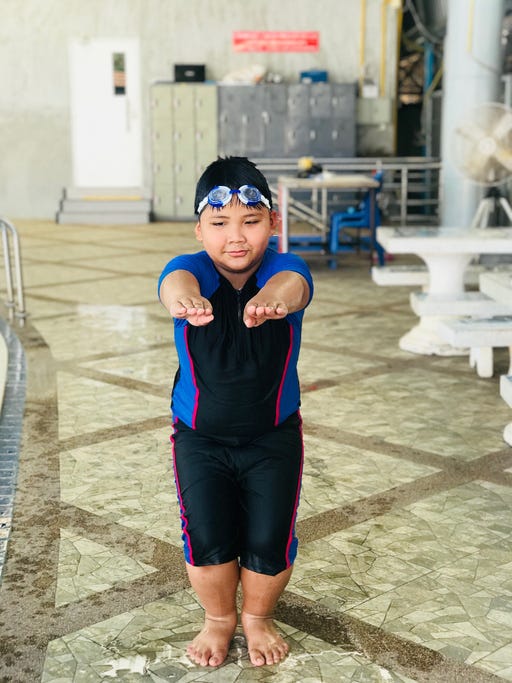Fatphobia, Aesthetic Athletics and Youth Sports
How much is a little girl worth? And who doesn't even get to play?
It’s time for your monthly book research roundup!
This month, I’m working on a chapter about anti-fat bias in kids’ sports, dance and other physical activities. This bias can be as explicit as coaches pushing diets and weight loss or telling kid to “make weight” before a meet. But it’s often much more implicit: Kids get cut from a team or aren’t encouraged to audition because they don’t have the “right” body for the activity (especially once they get into puberty). Uniforms or costumes aren’t size-inclusive. Or there’s just a general culture of intolerance around body size that makes these activities feel unsafe to kids in bigger bodies. And that’s harmful to kids of all sizes, at every level of athletic ability.

You shared some of your stories in this Friday Thread, which helped direct my reporting. Here’s a rundown of what I’ve been reading and thinking about in the course of working on this one. If you ever played sports or danced, or if you have a child with one of these passions… buckle up. There’s a lot here.
CW: Many of the articles I link to use weight-stigmatizing language because science is full of anti-fat bias and so is media coverage about sports. A few articles also discuss child abuse.
Kids’ Sports Have Gone Pro
As Anne Helen Petersen wrote in her excellent polemic:
It is a travel team for kids starting at age seven. It is specialized coaches for different positions. It is mandatory three to four mandatory practices a week, plus at least two days of competition. It is the very use of ‘elite’ to describe a child. It is national rankings for those same children. It is the expectation of $4000-$6000 a year spent for each kid in hockey, upwards of $3700 for baseball, and between $2500 and $6000 for soccer. It is private and almost always for-profit, even if those profit margins are slim. It is the specifics of this system but it is also the generalized idea that this is an okay way to organize a childhood.
It’s been particularly interesting working on this chapter during Winter Olympics discourse. Americans are quick to judge the Russian system of destroying child athletes. Here’s Joan Ryan, author of Little Girls in Pretty Boxes, on the doping of Kamila Valieva.
But we’re kidding ourselves if we think Americans aren’t also part of the problem, or that we don’t subscribe to the same racist, fatphobic and misogynistic double standards, as Lyz Lenz outlines here. Hello, Simone Biles, and all the gymnasts harmed by Larry Nassar.
“How much is a little girl worth?” asked Rachael Denhollander, the first American gymnast to publicly accuse Nassar of abuse, asked the right question during his 2018 legal case. Writes Rita Wenxin Wang for Slate: “The Court of Arbitration for Sport’s decision to let Kamila Valieva compete answers the question: nothing.”
The pressures on male athletes, especially child athletes, are also insane. And their bodies are also targets of child abusers.

But even male figure skaters say that female figure skaters face more anti-fat bias and body shaming.
I’m also thinking a lot about everything that Karen Chen’s homemade costumes symbolize: Her bond with her mother. The very American story of immigrant sacrifice. The insane cost and expectations of figure skating dresses and figure skaters’ bodies.
And let’s not forget Mary Cain’s story. It isn’t only aesthetic athletics like gymnastics, dance and figure skating that come with rigid body norms and expectations of perfection.
I wrote more about Mary Cain, Good Girls and thinness here.
Kids’ Sports Aren’t Really About Health
If they were, we wouldn’t see many high school and college athletes at heightened risk for eating disorders and injuries.
The condition previously known as Female Athlete Triad, is now called RED-S (Relative Energy Deficiency in Sports) to reflect the fact that it can happen in athletes of all genders1. Research on RED-S is very new, but the papers we have so far have documented it in 22 to 58 percent of athletes studied.
More on the dangers of RED-S here.
Meanwhile, Norwegian ski jumper Maren Lundby decided not to lose weight dangerously even though it would mean also deciding not to compete in Beijing. Why is that the choice?
Several of Canada’s top synchronized swimmers allege that they were coached into eating disorders. The program has promised to overhaul its safety policies, while critics say the problem goes way beyond the Olympic level. (Paywall on these.)
When dancers get injured, they are more likely to develop disordered eating.
When exercise is your identity, you are more likely to exercise in unhealthy ways.
Who Doesn’t Get To Play?
As AHP’s piece notes, anyone who can’t afford thousands of dollars per year on team fees, equipment, uniforms or costumes, and travel. (Also, kids of working parents who can’t figure out how to get them from school to an activity.)
But also, fat kids. Adults who were fat as kids report “a continuous decrease of physical activity from childhood to mid-adulthood.”
Research shows that people in larger bodies “exclude themselves from sport and exercise settings due to traumatic weight stigma experiences, self-discrimination and fear of stigma.” Let’s question the use of “exclude themselves” here; pretty sure it’s the stigmatizing culture that does the excluding?

This larger study documents a similar phenomenon. And so does this literature review, which includes data on kids. This review linked negative body image (which is distinct from the experience of weight stigma) to lower participation rates.
Quitting isn’t the worst idea: This study of over 500 teenage girl athletes found that their body-related shame and guilt increased, and pride decreased, after three years of playing sports.
That study only documented a correlation, but the culture of athletics clearly contributes: ‘Can you move your fat ass off the baseline?’ explores the sport experiences of adolescent girls with body image concerns.
When fat kids do play sports, or even just play, period, it’s often because they’ve been steered towards an activity with the hope that it will make them smaller. (Big CW on that study!)
What Can We Do?
There’s a strong case for studying coaches. And bringing anti-bias training into exercise science.
Teaching parents, teachers and coaches to model body positivity would help. And so would redesigning uniforms.
Referees could also do more about comments like “Go after the fatty.”
We could teach kids about intuitive exercise instead. (I especially like this book.)
It’s also okay if movement isn’t always joyful, writes Ragen Chastain.
POST-PUBLICATION UPDATE:
Readers have sent several great links to add to this list, so I’m updating as I get them.
Here’s Britni de la Cretaz on the fat-positive potential of sports.
Their piece reminded me we always need to reckon with the way Olympic body diversity is celebrated, but also tokenized.
And here’s Natalia Mehlman Petrzela’s new piece on what it will take to build a better movement culture.
Also. Here’s a tangentially-related recent exercise revelation for adults like me who are still unpacking all the ways gym class, youth sport, and 1990s fitness culture taught us to think about “working out:”

Only menstruating athletes are at risk for losing their period, but all genders can experience the dire physical consequences of not eating enough to support your sport.




Your piece gave me a thought. As a fat kid, i was never allowed to “play” at all. Instead, i was forced to “exercise.” And believe me, there’s a world of difference in those two words.
I have so much to say. My kiddo was a high level competitive gymnast, on track for division 1 college level gymnastics (that’s a really big deal). She was working out 25 hours a week. Not because we wanted her to but because she wanted to and her coaches wanted her to. Right before she turned 13 she decided to stop because it wasn’t bringing her joy (I’m so proud of her for making this decision!). Since then, her periods have normalized, she’s grown numerous inches and gone up a clothing size or 2 even though she is now doing cross country running, rock climbing, and riding her bike 2 miles (total) every day to get to and from school. We celebrate her growth every step of the way. Also? She’s turned into a different person. She used to be shy and quiet. Now she’s gregarious and outgoing. There was nothing wrong with shy and quiet and we always thought it was just her personality. This person who has time to explore new things and who isn’t exhausted all the time? Is a chatterbox who likes getting the shy kids to open up and talk. She’s now much more accepting of people and celebrates differences rather than thinking they’re “strange”. She went from telling us that she never wanted to go on a trip or to a camp without us to asking to go on a school trip to Europe for 10 days where parents aren’t allowed to chaperone (she’s going!). Some of this could be maturity but most of it we attribute to stopping gymnastics. She was at a great gym with coaches we loved who were very aware of eating disorders and always prioritized the child’s health over gymnastics. One of the coaches is a legend in gymnastics and had a very abusive parent and coach growing up. She protects those girls like a total mama bear and is hyper aware of eating issues. They gave classes on proper nutrition for their growing bodies…and still…it had a very negative impact on my kid’s body and mind. Stopping gymnastics was one of the best things my kiddo ever did.